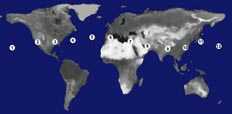Sunpendulum
Sunpendulum is an art, science and technology project[1] devised by Austrian media artist Kurt Hofstetter.[2]
Concept
- Watching the sky: "Inplusion" phase
Twelve video cameras called "time-eyes" are connected to the internet in twelve locations in twelve time zones around the Earth, observing the sky twenty four hours per day, continuously creating a hypothetical "sun clock" which spans the planet.[3]
- Installations

- 1999 Maui, Bermuda and Granada [citation needed]
- 2000 Cairo, New Orleans and Ensenada [citation needed]
- 2001 Azores [citation needed]
- 2002 Dubai [4]
- 2003 Hong Kong [5]
- 2004 Kolkata [6]
- 2005 Tokyo [7]
- 2006 Marshall Islands [8]
- Viewing the results: "Explosion" phase
→ Note: This section describes "pavilions" which have not been constructed or installed.

At a location to be determined within each time zone, twelve screens are intended to be arranged in a circle within a pavilion[9] meant to remain open for visitors twenty four hours per day. The screens, connected online with the time-eyes, transmit the images from the twelve time zones.[10] As the earth rotates, the images transmitted by the time-eyes move within a pavilion's circle of screens where day and night may be vicariously experienced in parallel.
Each pavilion, a circular structure of twenty four pairs of half cylinders, each pair of which resembles in horizontal cross section the Hopi symbol ( ) for universal brotherhood,[11] is intended to allow twenty four points of entry for visitors while preventing local light from reaching the screens. An arrangement of rooftop solar cells is hypothesized to produce the necessary energy.[10]
Kernel team
The kernel team consists of scientists (chiefly from the Institute of Computer Graphics and Algorithms at the Vienna University of Technology) and artists. Its primary tasks are ongoing technical developments which maintain the integrity of the project and its hardware and software.
Collaboration partners
The collaboration partners are scientific and academic institutions which host the time-eye cameras, hardware and servers and participate in the project's international cross-cultural cooperation.
- University of Hawaii and Maui Community College [citation needed]
- Autonomous University of Baja California [citation needed]
- University of New Orleans [citation needed]
- Bermuda Underwater Exploration Institute [citation needed]
- University of the Azores [citation needed]
- University of Granada [citation needed]
- Ain Shams University [citation needed]
- Zayed University [4]
- Jadavpur University [6]
- Hong Kong University of Science and Technology [5]
- Kanazawa Institute of Technology [7]
- College of the Marshall Islands [8]
References
- ↑ "The Sunpendulum Concept". INST Research Institute for Regional and Transnational Processes. 1993. Retrieved June 2007.
- ↑ "Kurt Hofstetter, Member of Parallel Media". Basis Wien Kunst, Information und Archiv (in German & English). Retrieved June 2007.
- ↑ "Inplusion: 12 time-eyes around the earth watch the sky". Project website. Retrieved June 2007.
- ↑ 4.0 4.1 Staff reporter (13 February 2002). "ZU selected as site for Sunpendulum project". Khaleej Times. Retrieved June 2007.
- ↑ 5.0 5.1 ""Time-Eye" at HKUST Puts Hong Kong on Global Hi-Tech Media Art Scene". Hong Kong University of Science and Technology website. 13 March 2003. Retrieved June 2007.
- ↑ 6.0 6.1 Anisha Baksi. "Solar Power". The Statesman. Retrieved June 2007.
- ↑ 7.0 7.1 "February News: Media art of terrestrial scale: The Kanazawa Institute of Technology future design laboratory (Tokyo)". KITnet.jp news (in Japanese). (A google search for Kanazawa sunpendulum will yield a link which can be translated into English.). February 2005. Retrieved June 2007.
- ↑ 8.0 8.1 "Sunpendulum Project - International video monitoring, one at CMI, Majuro". yokwe.com. 3 October 2006. Retrieved June 2007.
- ↑ "Sunpendulum pavilion #2, Station F / model". Project website. Retrieved June 2007.
- ↑ 10.0 10.1 "Explosion: 12 time-screens transmit the sunlight from around the earth". Project website. Retrieved June 2007.
- ↑ Carl G. Liungman, Dictionary of Symbols, 1991, p 175
External links
- Institute of Computer Graphics and Algorithms (ICGA) website.
- Bermuda Underwater Exploration Institute (BUEI) website.